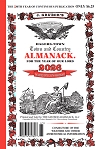Imitators of The Hagerstown Almanack Part 2
BUY THE GENUINE ACCEPT NO OTHER
Thomas G. Robertson died in 1869; his widow, Caroline V. Robertson continued publication of the Gruber almanac. But in June 1873, instead of renewing the arrangement that the Robertsons had maintained with the Grubers for nearly twenty years, the Gruber heirs, represented by John Gruber’s daughter, Frederica, contracted with Milton A. Berry, a Hagerstown dentist who had earlier been a publisher, to continue the almanac. Later that same year, Berry formed a partnership with Otho Swingley, who had published the 1860s Gruber imitation. The new publisher was to begin with the 1875 Gruber’s.
The Robertsons were furious. They believed that their contract with the Grubers had one more year to run, and they also made plans to publish the 1875 Gruber’s. In August of 1874, shortly before the 1875 almanac was to appear, apparently in two competing editions with the same title, the Gruber heirs went to the Circuit Court of Washington County and won an injunction to prevent the Robertsons from infringing on the trademarks of Gruber’s Almanack.
Since Caroline Robertson was prohibited from continuing the Gruber almanac, she began an almanac of her own. She turned what she had intended to be the 1875 Gruber’s into the first issue of C. V. Robertson’s Hagers-Town Almanack (she shortly changed the title to emphasize her late husbands’ name: For the remainder of its career, it was T. G. Robertson’s Hagers-Town Almanack).
In her first issue and in newspaper advertisements entitled "Hagerstown Almanack in a Nut Shell,” she vented her fury, claiming that the success of Gruber’s was entirely due to the publication skills of her late husband, that the Grubers were showing "singular ingratitude toward the family of Mr. R[obertson], to whom they were so largely indebted,” and that in the future her almanac should be considered "the true and only genuine issue of the Hagerstown Almanack.”
Frederica Gruber responded with a strenuous denial that Robertson’s abilities had anything to do with the success of an almanac that had already been published for fifty-seven years when he became associated with it; she stated that he was "nothing more than our business agent,” and that the "only genuine ‘Gruber[’s] Hagerstown Almanack’ is that being now published by Dr. M. A. Berry.”
Caroline Robertson’s almanac was so close to Gruber’s that there can be little doubt that it was intended to seem the same work to casual purchasers. Both almanacs had a cover with an elaborate border of vegetation, with an eagle at the top and a large woodcut at the bottom. The cover text layout was practically identical, even to spelling Hagers-Town with a hyphen and Almanack with a k. Both back covers had identical multiplication tables, the title pages and inside front covers were nearly identical, and the layout and woodcuts for the calendar pages were the same.
In 1875, Caroline moved to Baltimore, taking T. G. Robertson’s Hagers-Town Almanack with her. In August of 1878, Milton A. Berry, Otho Swingley, and the Gruber heirs signed a petition against Caroline V. Robertson, asking for an injunction against her publication. They claimed that Caroline Robertson had violated the Grubers’ trademark, especially with her front cover, which the plaintiffs insisted was intended to lead people to the erroneous belief that it was J. Gruber’s Hagers-Town Town and Country Almanack. In other words, the plaintiffs claimed that Caroline was attempting to profit from the reputation earned by another publication. Both courts had little trouble in deciding that her almanac was indeed a blatant imitation of Gruber’s Almanack.
For more on IMITATORS OF THE HAGERSTOWN ALMANACK, click here


















